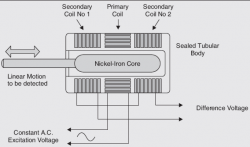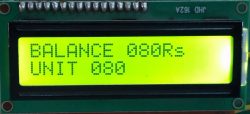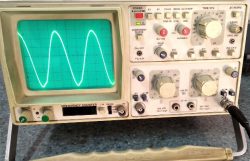Table of Contents
What is Linear Variable Differential Transducer (LVDT)?
Definition of LVDT Transducer: LVDT stands for “Linear Variable Differential Transducer“. LVDT is a passive differential inductive transducer. This is a variable inductance displacement transducer.
The LVDT is the most common mutual inductance element. This can be considered to be an optimum transducer element for most electro-mechanical measuring systems with regard to resolution, hysteresis, dynamic response, temperature characteristics linearity, and life.
Construction of LVDT
- It consists of a primary winding and two identical secondary windings. These windings are axially spaced and bound on a cylindrical coil former.
- A rod-shaped magnetic core is positioned centrally inside the coil assembly. This rod provides a low reluctance path for the magnetic flux linking the coils (windings).
- The moving object displacement of which is measured is coupled to this movable rod.
- The two secondary winding are connected in series opposition. Hence the voltages induced into these windings are of opposite polarities.
- The output voltage is given by E0 = E01 – E02
- Where E01 and E02 are the emf induced in two secondary windings.
- The transfer characteristic of LVDT is shown in the figure.
- It is the graph of output voltage against the core position.
Operation of LVDT
- The primary winding is connected to the ac source.
- Assume that the core is exactly at the center of the coil assembly. Then the flux linked to both the secondary windings will be equal.
- Due to equal flux linkage, the secondary induced voltage is equal, but they have opposite polarities.
- The output voltage of LVDT i.e. E0 is, therefore, zero correspondings to the central portion of the core. This position of the core is called the “null position”.
- Now, if the core is displaced from its null position towards secondary-1, then the flux linked to secondary-2 increases, and flux linked to the secondary-2 to decreases.
- Therefore the induced voltage eo1 is now greater than E02 and the output voltage of LVDT i.e. E0 will be positive.
- Similarly, if the core is displaced downwards i.e. towards the secondary-2 then E02 will be greater than E01 and the output voltage e0 will be negative.
- Thus the magnitude of the output signal is made a very “linearly” with the mechanical displacement. Hence the word linear is used for LVDT.
- The output is obtained “differentially” between the two secondary windings. Hence, the word “differential” is used in LVDT.

Advantages
- Linearity: The output voltage of Linear Variable Differential Transducer is almost linear for displacement up to 5mm.
- Infinite Resolution: The charge in output voltage is continuous, step-less. The effective resolution depends more on the equipment used for the measurement rather than on the LVDT.
- High Output: Linear Variable Differential Transducer gives reasonably high output and hence requires less amplification afterward.
- High Sensitivity: LVDT has a high sensitivity of about300 mV/mm: i.e., 1 mm displacement of the core produces an output voltage of 300mV.
- Ruggedness: This transducer is mechanically rugged and can withstand mechanical shock and vibrations.
- Less Friction: Since there are no sliding contacts, the friction is very less.
- Low Hysteresis: It has a low hysteresis; hence its repeatability is extremely good under all conditions.
- Low power Consumption: Most LVDTs consume less than 1 W of power.
- This transducer is small, simple, and light in weight. They are stable and easy to align and maintain.
Disadvantages
- It is sensitive to external magnetic fields. To minimize this effect magnetic shielding is necessary.
- Complicated circuitry is needed.
- Due to mass of the core, It is not suitable for dynamic measurement.
- Large displacements are needed to get appreciable differential output.
- Temperature affects the transducer.
Applications
- It can be used in all applications where displacement ranging from fractions of a few mm to a few cms has to be measured.
- Acting as a secondary transducer, Linear Variable Differential Transducer can be used as a device to measure force, weight, and pressure, etc. The force or pressure to be measured is first converted into a displacement using primary transducers. Then this displacement is applied to an LVDT, that acts as a secondary transducer, and converts the displacement into a proportional output voltage. In these applications, the high sensitivity of LVDT is a major attraction.






